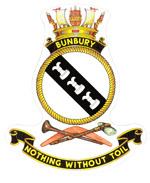Laid down 29 July 1977 Decommissioned 11 February 2006 Construction started 29 July 1977 Length 42 m Builder NQEA Australia | Commissioned 15 December 1984 Motto "Nothing without toil" Launched 21 June 1978 Draft 1.75 m | |
 | ||
Honours andawards Two inherited battle honours | ||
HMAS Bunbury (FCPB 217), named for the city of Bunbury, Western Australia, was a Fremantle class patrol boat of the Royal Australian Navy (RAN).
Contents
Design and construction
Starting in the late 1960s, planning began for a new class of patrol boat to replace the Attack class, with designs calling for improved seakeeping capability, and updated weapons and equipment. The Fremantles had a full load displacement of 220 tonnes (220 long tons; 240 short tons), were 137.6 feet (41.9 m) long overall, had a beam of 24.25 feet (7.39 m), and a maximum draught of 5.75 feet (1.75 m). Main propulsion machinery consisted of two MTU series 538 diesel engines, which supplied 3,200 shaft horsepower (2,400 kW) to the two propeller shafts. Exhaust was not expelled through a funnel, like most ships, but through vents below the waterline. The patrol boat could reach a maximum speed of 30 knots (56 km/h; 35 mph), and had a maximum range of 5,000 nautical miles (9,300 km; 5,800 mi) at 5 knots (9.3 km/h; 5.8 mph). The ship's company consisted of 22 personnel. Each patrol boat was armed with a single 40 mm Bofors gun as main armament, supplemented by two .50 cal Browning machineguns and an 81-mm mortar, although the mortar was removed from all ships sometime after 1988. The main weapon was originally to be two 30-mm guns on a twin-mount, but the reconditioned Bofors were selected to keep costs down; provision was made to install an updated weapon later in the class' service life, but this did not eventuate.
Bunbury was laid down by the North Queensland Engineers and Agents at Cairns, Queensland on 13 June 1983, launched on 3 November 1984, and commissioned into the RAN on 15 December 1984.
Fate
Bunbury was decommissioned on 11 February 2006. The patrol boat was broken up for scrap in Darwin during 2006 and 2007, at a cost of $450,000 to the Australian government.
